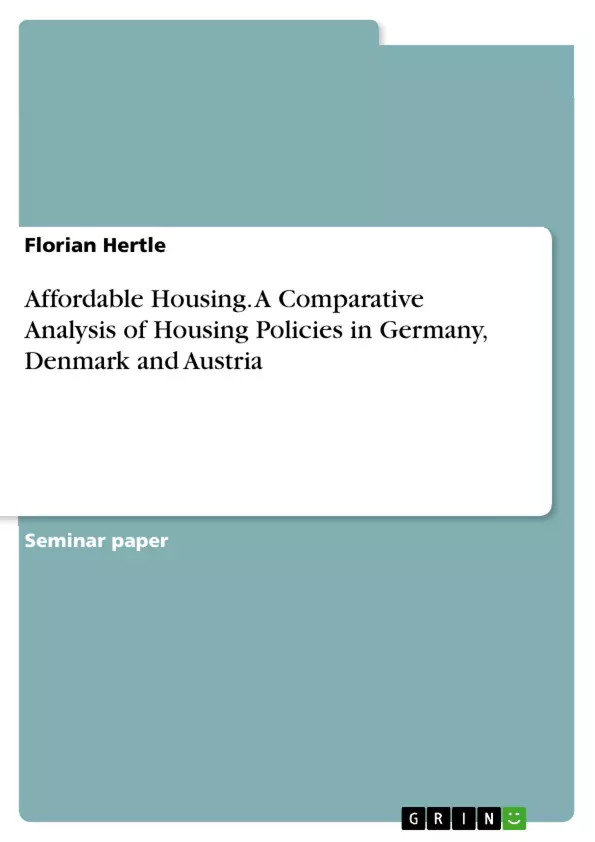Affordable housing is a hot topic in today’s realm of public policy debates. Public unwillingness to accept ever increasing rent burdens is growing, especially in the metropolitan centers, giving rise to new social movements demanding and claiming their ‘right to the city’. The analysis at hand is aimed at comparing the German housing policy with policy alternatives from Austria and Denmark with regards to their effectiveness and efficiency in promoting the goal of affordable housing.
Inhaltsverzeichnis (Table of Contents)
- Introduction
- Background
- Analysis of the housing policy context
- Review of the German housing policy
- Housing Policy Problem
- Identification of the housing policy problem
- Identification of the actors and their interests
- Monitoring and Evaluation of the housing policy
- Definition of the monitored housing policy and its main indicators
- Definition of the German housing policy model and the logical frame
- Housing policy alternatives Austria and Denmark
- Definition of Housing policy Alternatives of Austria and Denmark
- Specification of the Austrian and Danish housing policy alternatives
- Evaluation and Comparison of the Austrian and Danish policy alternatives
- Selection of the best alternative housing policy aspect
- Conclusion and housing policy recommendations
Zielsetzung und Themenschwerpunkte (Objectives and Key Themes)
This analysis compares the German housing policy with policy alternatives from Austria and Denmark, focusing on their effectiveness and efficiency in promoting affordable housing. The study aims to identify the strengths and weaknesses of each policy model and propose recommendations for improving the German housing policy.
- The rising cost of housing in major cities and the impact on affordability.
- The role of different actors and their interests in shaping housing policies.
- Analysis and evaluation of the effectiveness of current housing policies in Germany, Austria and Denmark.
- Comparison and evaluation of the different policy instruments and mechanisms.
- Identification of potential policy recommendations based on best practices and evidence-based approaches.
Zusammenfassung der Kapitel (Chapter Summaries)
- Introduction: This chapter sets the stage by introducing the pressing issue of affordable housing in modern cities. It frames the analysis by defining affordable housing as a social right and explains why a comparative study of Germany, Austria and Denmark is relevant.
- Background: This section delves into the context of housing policies. It analyzes the broader challenges cities face in providing affordable housing and reviews the current state of German housing policy, including the rent benefit system and the rent brake.
- Housing Policy Problem: This chapter identifies the housing policy problem in Germany. It highlights the growing housing shortage, rising rents, and the affordability challenges faced by low-income households. It also analyzes the involvement of stakeholders and their respective interests in shaping housing policy.
- Monitoring and Evaluation of the housing policy: This chapter defines the key indicators used to monitor and evaluate the effectiveness of the housing policies. It outlines the input, output, and outcome variables considered in the study and presents a logical frame for analyzing the different policy models.
- Housing policy alternatives Austria and Denmark: This chapter examines the housing policies of Austria and Denmark. It presents the core elements of each policy, including regulated rents and social housing programs. It analyzes the strengths and weaknesses of each policy model, including their effectiveness, efficiency, equity, and administrative implications.
Schlüsselwörter (Keywords)
This policy analysis focuses on affordable housing, housing policy, social housing, rental policy, housing assistance, rent regulation, stakeholder analysis, Germany, Austria, Denmark, efficiency, effectiveness, equity, and policy recommendations.
- Quote paper
- Florian Hertle (Author), 2020, Affordable Housing. A Comparative Analysis of Housing Policies in Germany, Denmark and Austria, Munich, GRIN Verlag, https://www.grin.com/document/989484



